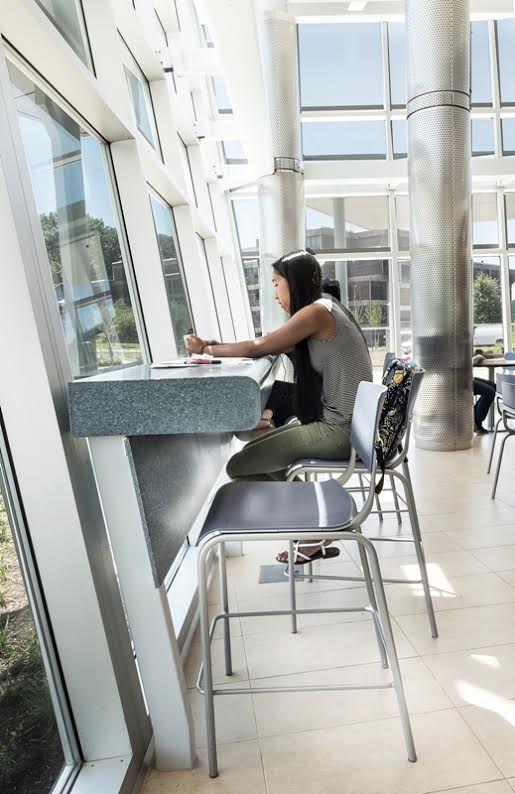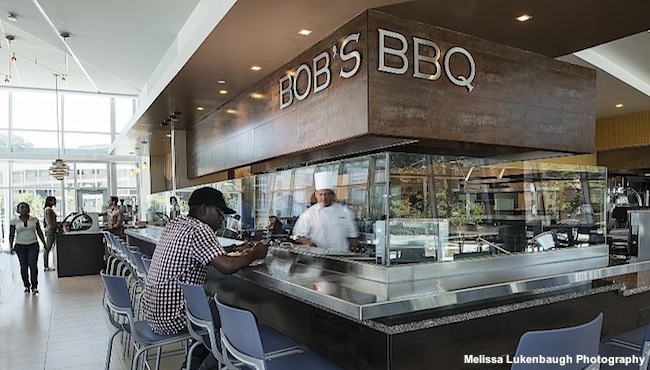Creating a dining experience for the modern millennial requires not only a deep knowledge of good design, but also an understanding of what makes today’s students tick.
KSQ Architects dining specialist Juana Gomez, as well as culinary designers and consultants from Bakergroup and Ricca Newmark, recently provided insights into what trends are transforming the campus table.
1. Food is community
Sure, some students simply want to eat in peace–and creating bar height spaces where they can feel comfortable dining alone is key. But because family is increasingly important to the millennial generation, many students prefer the communal act of dining with others. This shared experience gives birth to community and raises the level of engagement on campus.
In fact, a survey of 1,000 millennials by marketing agency BBDO Atlanta found that “48% said their families define them, and 16% said their passions do. Honesty ranked highest in what matters most in how they live their lives. Pretentions are out. Honesty and transparency are in. And, integral to their lifestyle is the food they eat and the people they eat it with.” Flexible spaces that support any given mood–whether solitary or communal–are key to any successful student dining project.
2. Restaurant, not cafeteria
Dining halls today are not the cafeterias of yesterday. Today’s students want a more retail experience and they want variety–and ideally multiple choices of fresh foods prepared right in front of them and to their specifications. In fact, the BBDO survey also found that nearly five out of 10 millennials refer to themselves as foodies. Sophisticated yet durable finishes, comfortable lighting and seating, and inviting spaces to simply hang out whether they’re hungry or not.
“Dining on campus is evolving more into commercial restaurants and farther away from the “stainless” cafeterias of my collegiate days. Instead of “dining halls” we are going to “mini-restaurants” and “marketplaces,” says Tom Ricca, founder of culinary design firm Ricca Newmark. “Student dining rooms today are furnished with upholstered booths and banquettes with highly designed ceilings and lighting.”
3. Connection to the outdoors

Photo credit: Melissa Lukenbaugh Photography, courtesy of KSQ Architects
Whether it’s an indoor space flooded with natural light or a true al fresco dining experience, students crave sunlight as much as a slice ofpizza. Nothing raises the mood, inspires conversation and communicates hospitality like a wall of windows or a patio full of tables.
“Especially in climates that are more temperate, we like to provide spaces that allow students to take the dining experience outside,” says KSQ associate and dining specialist Juana Gomez. "Having options is vitally important to students today, and al fresco dining–with a variety of seating choices–really lets millennials create what feels like a customized eating experience.”
4. Food origins
Not only do 21st century college students think differently about food than any previous generation, they also care deeply about the origins of their food–whether the emphasis is on how it’s grown, where it’s grown or who grew it, the ethical factors that come into play are increasingly important to this new generation.
“Students are also seeking more transparency and authenticity in the preparation of their food, reflected in the popularity of exposition cooking and artisan foods, and in the demand for fresh ingredients,” says Jim Sukenik, president of food service consultant Bakergroup. “A movement toward local food sourcing is a driver of chef-driven menus that frequently change, based upon the seasonal availability of some items.”
5. Spaces with flex appeal
Let’s face it–today’s millennial is easily bored. Finding ways to keep a dining hall ever new is a challenge that can be achieved with revolving art exhibits, new music, updated menus and branding opportunities. Keeping the experience fresh is a key factor in making dining a place that pulls kids from all corners of campus.
“Like a storefront window, the dining hall ideally has something new going on all the time,” says KSQ’s Gomez. “Often a small stage–for students to play music, have poetry readings or do improv–can be a big attraction.”
6. Convenience, always
A recent article by physicians with the Mayo Clinic noted that trends indicate 35% of meals eaten by millennials are actually snacks. Which means the portion sizes and dining hours need to be flexible. Whether it’s hours of operation or locations on campus, students tell us they want convenience and choice. Dining in with friends, grab-and-go on the way to class or delivery are also options students look for to make their hectic life a little easier.
“Convenience is paramount – foods that students want, where and when they want them,” says Sukenik. “Fresh, local, and healthy ingredients; smaller portion sizes; snacking and grazing in lieu of full meals, and “trading plates” are growing trends.” Tom Ricca agrees. “With the mobility of our youth, constantly connected, and time-challenged, we see the need for more and more “portable” foods that can be easily hand-held, packaged and eaten on the move. This would be items like burritos, pasties, and empanadas,” he says.
7. Going global

Photo credit: Melissa Lukenbaugh Photography, courtesy of KSQ Architects
From their own travel experiences to what they’ve seen on YouTube and Food Network, today’s students are far more savvy about ethnic foods, emerging food trends and unique dietary requirements to meet their needs. Students have also gravitated toward specialty beverages including craft teas, local soft drinks and infused water.
“The food itself responds to the ever-increasing sophistication of today’s teenager, who has eaten more meals in restaurants in his/herlifetime than at home, has travelled internationally and has experienced multi-cultural cuisines and cooking techniques from around the globe,” says Ricca. “Gone is the era of pizza, burgers and delis–now we have churrascos, Mongolian BBQ, dim sum and gyros.”
“Gluten-free menu items continue to gain traction, as many give up wheat products for health and lifestyle reasons,” adds Sukenik. “Ancient grains and nuts have become popular alternatives to wheat and meat, though smoked meats and other foods continue to rise in popularity,” he says.
8. Dine in, plug in

Photo credit: Melissa Lukenbaugh Photography, courtesy of KSQ Architects
Technology doesn’t stop with the lunch hour. In fact, for many students, the dining experience always includes either a smart phone, laptop or flatscreen TV. More than one-third of respondents to the BBDO survey said they like tech perks in dining venues, including ordering on iPads and pre-orderings with smart phones. Ironically, while 88% said they look at their phones while eating, 44% said they dislike it when their friends do.
Today’s dining halls feature seamless integration of technology, with power outlets built into furnishings, WiFi access (67% in the BBDO survey said they want free WiFi in restaurants) and digital connections to nutritional information, menus, surveys and even suggestion “boxes.” Walls with large-format televisions allow for communal TV or movie viewing and even the occasional video game tournament.
“Students today want to stay connected, even when they’re dining,” says KSQ’s Gomez. “Even if a dining hall doesn’t feature televisions, kids are looking at their phones. It’s a reality our designs must support—this is a generation that views their smartphone as a physical extension."
Related Stories
K-12 Schools | Feb 18, 2023
Atlanta suburb opens $85 million serpentine-shaped high school designed by Perkins&Will
In Ellenwood, Ga., a southeast suburb of Atlanta, Perkins and Will has partnered with Clayton County Public Schools and MEJA Construction to create a $85 million secondary school. Morrow High School, which opened in fall 2022, serves more than 2,200 students in Clayton County, a community with students from over 30 countries.
Multifamily Housing | Feb 16, 2023
Coastal Construction Group establishes an attainable multifamily housing division
Coastal Construction Group, one of the largest privately held construction companies in the Southeast, has announced a new division within their multifamily sector that will focus on the need for attainable housing in South Florida.
Sustainability | Feb 9, 2023
University of Southern California's sustainability guidelines emphasize embodied carbon
A Buro Happold-led team recently completed work on the USC Sustainable Design & Construction Guidelines for the University of Southern California. The document sets out sustainable strategies for the design and construction of new buildings, renovations, and asset renewal projects.
Giants 400 | Feb 9, 2023
New Giants 400 download: Get the complete at-a-glance 2022 Giants 400 rankings in Excel
See how your architecture, engineering, or construction firm stacks up against the nation's AEC Giants. For more than 45 years, the editors of Building Design+Construction have surveyed the largest AEC firms in the U.S./Canada to create the annual Giants 400 report. This year, a record 519 firms participated in the Giants 400 report. The final report includes 137 rankings across 25 building sectors and specialty categories.
University Buildings | Feb 8, 2023
STEM-focused Kettering University opens Stantec-designed Learning Commons
In Flint, Mich., Kettering University opened its new $63 million Learning Commons, designed by Stantec. The new facility will support collaboration, ideation, and digital technology for the STEM-focused higher learning institution.
University Buildings | Feb 7, 2023
Kansas City University's Center for Medical Education Innovation can adapt to changes in medical curriculum
The Center for Medical Education Innovation (CMEI) at Kansas City University was designed to adapt to changes in medical curriculum and pedagogy. The project program supported the mission of training leaders in osteopathic medicine with a state-of-the-art facility that leverages active-learning and simulation-based training.
Giants 400 | Feb 6, 2023
2022 Reconstruction Sector Giants: Top architecture, engineering, and construction firms in the U.S. building reconstruction and renovation sector
Gensler, Stantec, IPS, Alfa Tech, STO Building Group, and Turner Construction top BD+C's rankings of the nation's largest reconstruction sector architecture, engineering, and construction firms, as reported in the 2022 Giants 400 Report.
University Buildings | Jan 30, 2023
How wellness is reshaping college recreation centers
Moody Nolan, a specialist in the design of college recreation centers, has participated in the evolution toward wellness on college campuses.
University Buildings | Jan 27, 2023
Ozarks Technical Community College's advanced manufacturing center is first-of-a-kind in region
The new Robert W. Plaster Center for Advanced Manufacturing at Ozarks Technical Community College in Springfield, Mo., is a first-of-a-kind educational asset in the region. The 125,000-sf facility will educate and train a new generation in high tech, clean manufacturing and fabrication.
K-12 Schools | Jan 25, 2023
As gun incidents grow, schools have beefed up security significantly in recent years
Recently released federal data shows that U.S. schools have significantly raised security measures in recent years. About two-thirds of public schools now control access to school grounds—not just the building—up from about half in the 2017-18 school year.

















